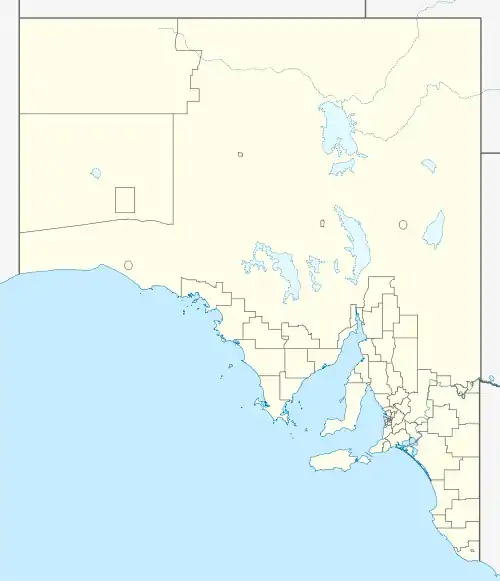Wattle Park, South Australia
Wattle Park is a suburb of Adelaide, South Australia in the City of Burnside.
| Wattle Park Adelaide, South Australia | |
|---|---|
 Wattle Park | |
| Coordinates | |
| Population | 1,830 (2006 census)[1] |
| Postcode(s) | 5066 |
| LGA(s) | City of Burnside |
History
The suburb may have been named by George Scarfe for the property, sections 288 and 289 totalling around 68 acres (28 ha),[2] that he purchased around 1880. His residence, renamed "Scarfe House", became in 1991 the centrepiece of "Wattle Grove" retirement village for Southern Cross Homes.
Olives
The Stonyfell Olive Company was founded by Joseph Crompton[3] with William Mair and Sidney Clark[4] in 1873, with planting continuing until 1882 across Stonyfell and adjoining areas.[5] By the 1900 had a 100 acres (40 ha) planted with about 10,000 olive trees, around Penfold Road.[6][7] In 1901, the company employed 81 workers.[5] This business became largely owned by the family of Owen Crompton (1875–1923) after his marriage to Sarah Simpson, daughter of A. M. Simpson, who settled on her the whole of his considerable stake in the company. With the inexorable expansion of Adelaide's suburbs, the land was sold to developers.[3] The olive crushing plant was actually in what is now Wattle Park, at the western end of Crompton Drive.[8] In August 1932, the Stonyfell Olive Company was the largest producer of olive oil in South Australia, and it entered into an agreement with Bickford's to do the bottling of the oil.[9]
Post office
Wattle Park Post Office opened on 8 April 1965 and closed in 1967.[10]
Facilities
There are no schools in Wattle Park. The closest school to Wattle Park is St Peter's Collegiate Girls' School in Stonyfell. Other schools nearby are Norwood Morialta High School (Senior Campus) and Magill Primary School in Magill. Wattle Park Kindergarten is located on Yeltana Avenue.
References
- Australian Bureau of Statistics (25 October 2007). "Wattle Park (State Suburb)". 2006 Census QuickStats. Retrieved 3 June 2008.
- "Mr G. Scarfe's Burnside Property". The Advertiser (Adelaide). South Australia. 19 November 1903. p. 6. Retrieved 10 May 2020 – via Trove.
- Crompton & Sons (1962), The Story of Joseph Crompton and the companies he founded, Crompton & Sons, retrieved 23 June 2020
- Findlay, Marjorie, "Crompton, Joseph (1840–1901)", Australian Dictionary of Biography, National Centre of Biography, Australian National University, retrieved 23 June 2020,
This article was first published in hardcopy in Australian Dictionary of Biography, Volume 3, (MUP), 1969
- Reichelt, K.; Burr, M. (1997). Extra Virgin: An Australian Companion to Olives and Olive Oil. Wakefield Press. p. 28. ISBN 978-1-86254-417-8. Retrieved 23 June 2020.
- "Burnside Heritage Survey (South Australia): Part 1: General Report (amended 1987)" (PDF). Prepared for the Corporation of the City of Burnside and the State Heritage Branch of the Department of Environment and Planning by John Dallwitz and Alexandra Marsden of Heritage Investigations, Adelaide 1986. Retrieved 23 June 2020. Cite journal requires
|journal=(help)CS1 maint: others (link) - "Stoneyfell Olive Yards". State Library of South Australia. Retrieved 23 June 2020.
- "Burnside's lost industry" (PDF). Newlsetter. Burnside Historical Society. 3 (3 September 1983): 5. September 1983. Retrieved 23 June 2020.
- "A Forward Step in the Development of a South Australian Industry". The Advertiser (Adelaide). South Australia. 20 August 1932. p. 15. Retrieved 23 June 2020 – via Trove.
- Premier Postal History. "Post Office List". Premier Postal Auctions. Retrieved 26 May 2011.